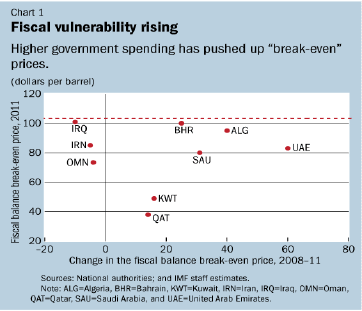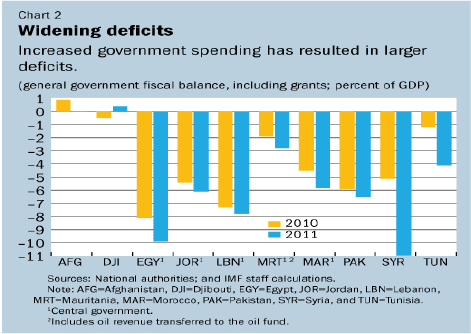Press Release: IMF Sees Varied Outlook for Mideast, with Oil-Importing Countries Facing Continued Economic Pressures
October 26, 2011
October 26, 2011
The economic outlook for countries across the Middle East and North Africa region varies markedly, with the oil-exporters seeing a mild pickup in growth in 2011 on the back of higher oil prices, and the oil-importers experiencing a dramatic slowdown, the IMF says in its latest assessment of the region. The IMF’s Regional Economic Outlook for the Middle East and Central Asia, released today, projects growth in the Middle East and North Africa region, including Afghanistan and Pakistan, at 3.9 percent in 2011, down from 4.4 percent in 2010.
The region’s oil-exporting countries (excluding Libya)—Algeria, Bahrain, Iran, Iraq, Kuwait, Oman, Qatar, Saudi Arabia, Sudan, the United Arab Emirates, and Yemen—are forecast to expand by 4.9 percent in 2011, thanks to higher oil prices and oil production. But growth among the region’s oil importers—Afghanistan, Djibouti, Egypt, Jordan, Lebanon, Mauritania, Morocco, Pakistan, Syria, and Tunisia—will register just under 2 percent (see table).
“Since the beginning of this year, a deterioration in the international economic outlook and the buildup of domestic social pressures have resulted in an economic slowdown in many of the region’s oil-importing countries. But we should not lose sight that the ongoing historical transformation holds the promise of improved living standards and a more prosperous future for the people in the region,” Masood Ahmed, Director of the IMF’s Middle East and Central Asia Department, said at the launch conference of the report in Dubai today.
Higher oil prices benefiting oil exporters
Economic activity in the region’s oil-exporting countries has clearly improved, bolstered by continued high energy prices. This expansion is driven by the high level of activity in the countries of the Gulf Cooperation Council (GCC), where growth is projected at 7 percent in 2011, the report shows. Several countries—Saudi Arabia in particular—have stepped up oil production temporarily in response to higher oil prices and shortfalls in production from Libya. “The decision to increase oil production in the wake of disruptions in Libya was an essential contribution toward global energy market stability and enhanced activity,” Mr. Ahmed noted.
Increased oil revenues have created additional room for government spending in the GCC. Several countries announced spending programs early in the year, covering a wide spectrum of measures, such as subsidies, wages, and capital expenditure. At current projected oil prices and levels of production, revenue gains will more than offset the high levels of public spending. In 2011, the oil exporters’ combined external current account balance is expected to increase from $202 billion to $334 billion (excluding Libya), and from $163 billion to $279 billion for the GCC.
But fiscal vulnerability has also increased substantially, as break-even oil prices have risen steadily and are now approaching observed oil prices (see Chart 1). “Oil-exporting countries have understandably increased fiscal spending to address social needs. Looking forward, the widening of non-oil fiscal deficits makes many countries more vulnerable to swings in oil prices, at a time when the world economy is facing heightened risks,” Mr. Ahmed added.

Turning to the financial sector, the report sees a continued gradual recovery. GCC banks in particular, which showed considerable resilience during the global crisis, are now registering capital adequacy ratios in excess of 15 percent, with nonperforming loans below 10 percent. But private-sector credit growth remains cautious.
Looking ahead, the IMF’s assessment foresees a moderation in growth for the region’s oil exporters to about 4 percent in 2012, and notes that these countries also face some downside risks. The most immediate would be the impact of a sharp slowdown in Europe and the United States. Global oil demand could contract substantially, possibly leading to a sustained drop in oil prices. Other risks include further regional unrest and an economic downturn in key trading partners, such as India and China.
Meeting social needs, restoring confidence key priorities for oil importers
As for the region’s oil-importing countries, the political and economic transformations occurring in several of them are advancing slowly and are expected to extend well into 2012. Together with a worsening economic outlook in Europe and globally, the region is seeing a sharp drop in investment and tourism activity. As a result, the recovery in 2012 is expected to be weaker than anticipated, with growth projected at just over 3 percent, according to the IMF report.
“Undoubtedly, the year ahead will be challenging for many countries, with continued political uncertainty, a deteriorating global economic outlook, and higher financing costs impeding a quick economic recovery. Measures aimed at restoring confidence and fostering more inclusive growth will help countries enhance activity and ultimately address the needs of the population,” Mr. Ahmed said.
In response to growing social unrest, the economic downturn, and higher commodity prices, governments in the region have significantly expanded subsidies and transfers. The cost of this social spending remains high, exceeding 10 percent of GDP in Egypt and more than 5 percent of GDP in most other countries. As a result, oil importers’ fiscal deficits are widening by about 1.5 percent of GDP in 2010–11 (see Chart 2).

In the near term, such spending measures are appropriate to lessen the impact of the downturn. But from an efficiency and equity standpoint, it is better for governments to gradually replace universal subsidies with social safety nets that are targeted at the less well-off part of the population, the IMF report states. Resources can then be used for critical investments in infrastructure and education and for supporting much-needed reforms.
Meeting the rising demands of the population will not be easy, the report notes—particularly as most countries have already used their fiscal and international reserve buffers to respond to deteriorating economic conditions in the wake of the Arab Spring, and have less room left to respond to future shocks. Regional partners and the broader international community can facilitate this transition through financing and greater market access for exports.
Conflict has taken a massive human toll in addition to its enormous economic costs in Libya, Syria, and Yemen. The immediate priority for these countries is to avoid further humanitarian crisis and, post conflict, to pursue an agenda of reconstruction and reform.
| Selected Economic Indicators Middle East, North Africa, Afghanistan, and Pakistan (MENAP) | |||||||||
| Average | Projections | ||||||||
| 2000–05 | 2006 | 2007 | 2008 | 2009 | 2010 | 2011 | 2012 | ||
|
Real GDP Growth |
|||||||||
|
(Annual change; percent) |
|||||||||
|
MENAP1 |
5.2 | 6.0 | 6.7 | 4.5 | 2.6 | 4.4 | 3.9 | 3.7 | |
|
Oil exporters1 |
5.6 | 5.9 | 6.8 | 4.0 | 1.8 | 4.4 | 4.9 | 3.9 | |
|
of which: GCC |
5.5 | 6.5 | 5.0 | 6.4 | 0.3 | 5.4 | 7.2 | 4.0 | |
|
Oil importers |
4.4 | 6.2 | 6.5 | 5.5 | 4.2 | 4.3 | 1.9 | 3.1 | |
|
of which: MENA oil importers |
4.1 | 6.4 | 6.1 | 6.4 | 4.9 | 4.5 | 1.4 | 2.6 | |
|
General Government Fiscal Balance |
|
|
|
|
|
|
| ||
|
(Percent of GDP) |
|||||||||
|
MENAP1 |
2.4 | 7.6 | 6.1 | 6.7 | -2.9 | -0.2 | 0.4 | 0.1 | |
|
Oil exporters1 |
6.0 | 13.9 | 11.9 | 13.0 | -1.6 | 2.9 | 4.6 | 3.6 | |
|
of which: GCC |
9.2 | 22.2 | 17.5 | 24.7 | -0.4 | 6.1 | 9.7 | 8.3 | |
|
Oil importers |
-5.3 | -4.8 | -5.2 | -5.4 | -5.2 | -6.0 | -7.6 | -6.7 | |
|
Current Account Balance |
|
|
|
|
|
|
|
| |
|
(Percent of GDP) |
|||||||||
|
MENAP1 |
7.8 | 16.2 | 12.8 | 13.4 | 1.8 | 7.0 | 10.4 | 8.2 | |
|
Oil exporters1 |
11.2 | 21.9 | 17.6 | 18.7 | 4.1 | 10.6 | 15.0 | 12.4 | |
|
of which: GCC |
13.4 | 25.4 | 19.7 | 22.5 | 7.1 | 15.0 | 20.6 | 16.9 | |
|
Oil importers |
-0.4 | -1.3 | -2.2 | -4.4 | -4.4 | -3.3 | -3.3 | -3.8 | |
|
Sources: National authorities; and IMF staff estimates and projections. 12011 and 2012 data exclude Libya. MENAP: (1) Oil exporters: Algeria, Bahrain, Iran, Iraq, Kuwait, Libya, Oman, Qatar, Saudi Arabia, Sudan, the United Arab Emirates, and Yemen; (2) Oil importers: Afghanistan, Djibouti, Egypt, Jordan, Lebanon, Mauritania, Morocco, Pakistan, Syria, and Tunisia. MENA oil importers: MENAP oil importers excluding Afghanistan and Pakistan. | |||||||||
IMF EXTERNAL RELATIONS DEPARTMENT
| Public Affairs | Media Relations | |||
|---|---|---|---|---|
| E-mail: | publicaffairs@imf.org | E-mail: | media@imf.org | |
| Fax: | 202-623-6220 | Phone: | 202-623-7100 | |


